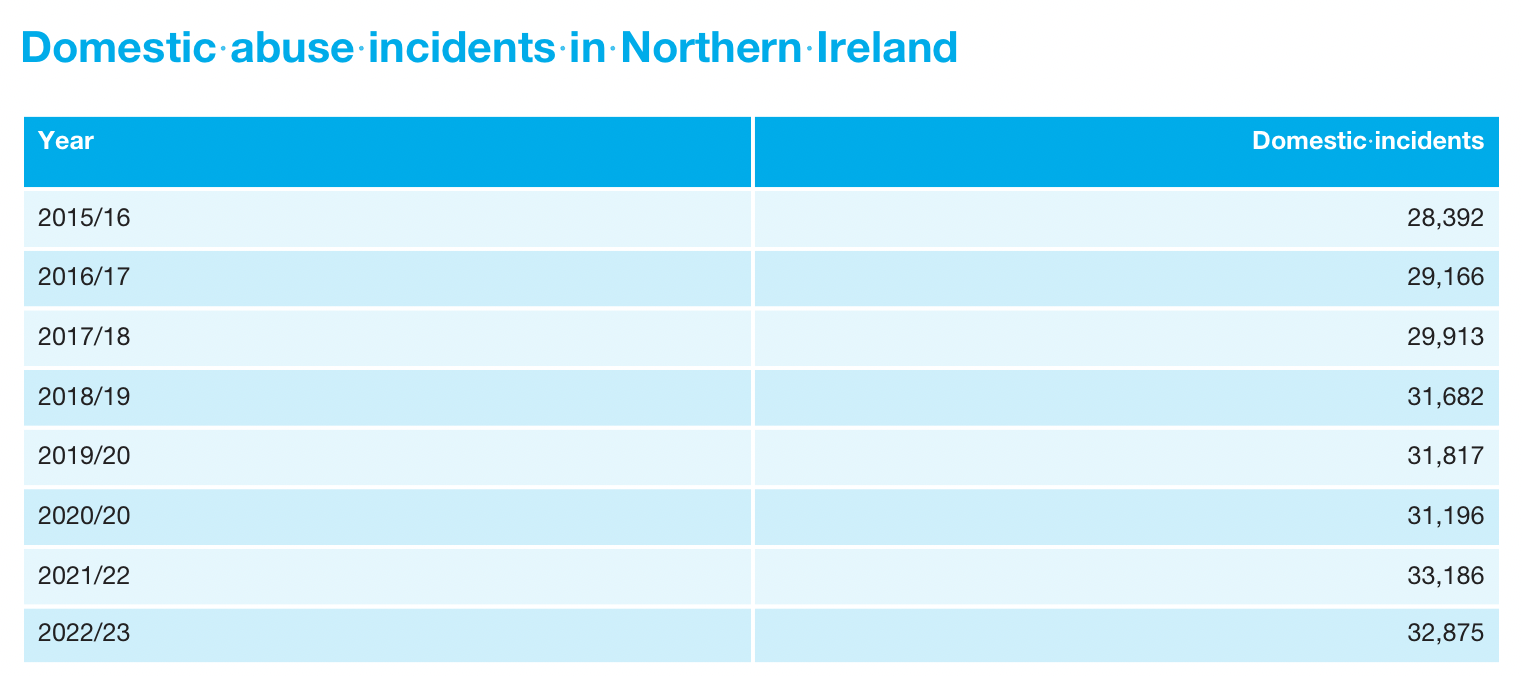Need to tackle domestic abuse failure

The draft Domestic and Sexual Abuse Strategy 2023-2030 will be the latest strategy which aims to tackle domestic and sexual abuse, following the conclusion of the Stopping Domestic and Sexual Violence and Abuse Strategy.
The original strategy, published jointly by former Minister for Health Simon Hamilton and former Minister for Justice David Ford in March 2016, can be characterised as a failure, with domestic incidents having increased from 28,392 in 2015/16 to 32,875 in 2022/23, according to statistics from the PSNI. The original strategy had been published with the intention of reducing domestic incidents.
When approached for comment on these figures, a spokesperson for the Department of Justice told agendaNi: “While awaiting the finalisation and publication of a new Domestic and Sexual Abuse Strategy by the Executive, both departments [Justice and Health] continue to provide support to victims.”
The spokesperson also said: “An ongoing priority is to address under-reporting in order to bring this previously hidden issue out into the open by encouraging and supporting victims to come forward and report abuse and access help.”
New draft strategy
The new draft strategy, published in February 2023, acknowledges this failure of delivery, although it claims that part of the reason for the increase in cases is “increased confidence in reporting”.
Whereas the Stopping Domestic and Sexual Violence and Abuse Strategy formally targeted a reduction in domestic and sexual abuse incidents, a metric which is already vague, the draft Domestic and Sexual Abuse Strategy 2023-2030 instead makes a revision of the underlying philosophy of the approach needed.
In its ‘learning and review’ section, the strategy promotes the domestic homicide reviews which have been in place since 2020 as well as the lessons from the Covid-19 pandemic which contributed to significant increases in the rates of domestic abuse.
Rather than setting specific targets, other than a general ambition to reduce domestic abuse cases, the strategy outlines the following objectives:
- increased co-operation and more effective collaboration across government, working in partnership with others;
- addressing social attitudes, while promoting awareness and knowledge of healthy relationships;
- providing support for those affected by domestic and sexual abuse, informed by their experience and the needs of particular groups;
- working to prevent domestic and sexual abuse taking place, identifying, and disrupting abusive behaviour while holding offenders to account; and
- providing a more robust and effective justice response, increasing protection and safety for those affected.
The draft strategy further calls for a “stronger system” which improves “how we respond to domestic and sexual abuse and working together to support those affected with a trauma informed approach”.
“We also want to harness every opportunity for positive intervention, so that abusive behaviour can be called out and addressed, with improved outcomes for all,” the strategy document states.
Of further importance, according to the draft strategy, is defining domestic abuse, which it states is: “Threatening, controlling, coercive behaviour, violence or abuse (psychological, virtual, physical, verbal, sexual, financial or emotional) inflicted on anyone (irrespective of age, ethnicity, religion, gender, gender identity, sexual orientation, or any form of disability) by a current or former intimate partner or family member.”

Eight outcomes
The draft strategy outlines eight outcomes which would be achieved by full implementation of the strategy. These are:
- a coordinated response to domestic and sexual abuse informed by victims’ voices and community engagement;
- the public is informed about the different types of domestic and sexual abuse and its impact on victims including children;
- an increase in the knowledge and skills of children, young people, and adults about forming healthy relationships;
- domestic and sexual abuse is identified and responded to earlier;
- victims including children are supported and feel safe regardless of diversity of need;
- all victims of domestic abuse including children can access safe accommodation-based services;
- individuals are responsible for their abusive behaviour, are held to account and supported to change, with the risk of harm reduced and victim safety enhanced; and
- victims feel confident to report domestic and sexual abuse, barriers to participating in the justice system are reduced and justice responses are effective.
Political instability
Less than nine months after the Stopping Domestic and Sexual Violence and Abuse Strategy was introduced, the Executive collapsed amid the fallout of the RHI scandal and remained inactive for almost three years.
The new Executive then itself collapsed after only two years, during which time there was a crisis of leadership in the DUP, the Covid-19 pandemic, and continued Brexit challenges. With the Executive having been inactive for around five of the last eight years, it is hard not to conclude that a lack of political leadership has left the Civil Service and relevant stakeholders rudderless in tackling domestic violence and abuse.
The failure to reduce domestic incidents can be partly explained by Covid, and partially attributed to an increase in reporting, but the statistics give no reason to believe that, as was intended, there has been any decrease in domestic incidents.
Some initiatives, such as domestic homicide reviews, which have been taken up will be of note if and when political leaders return to the Executive. However, the fact that, according to the PSNI, more than one-in-four women in Northern Ireland experience domestic abuse means reduction of domestic and sexual abuse is a challenge which will require considerable effort.





